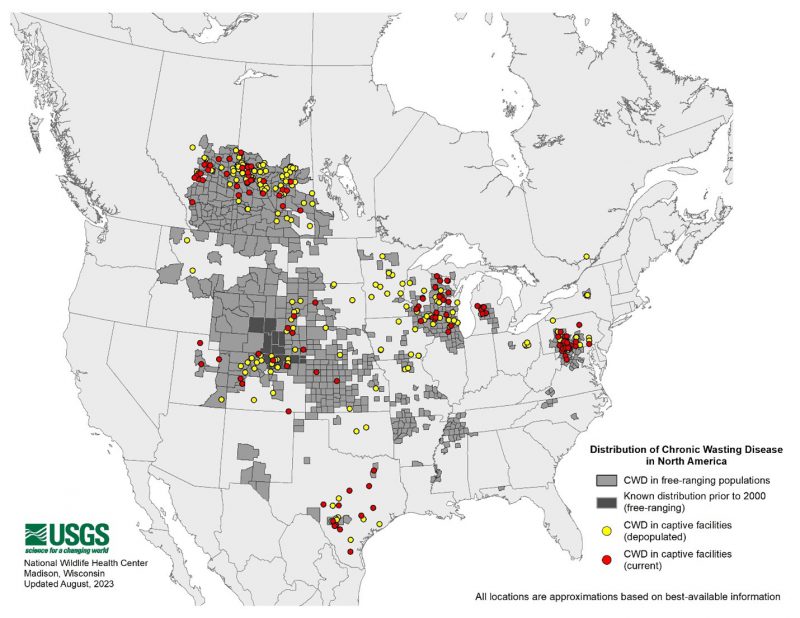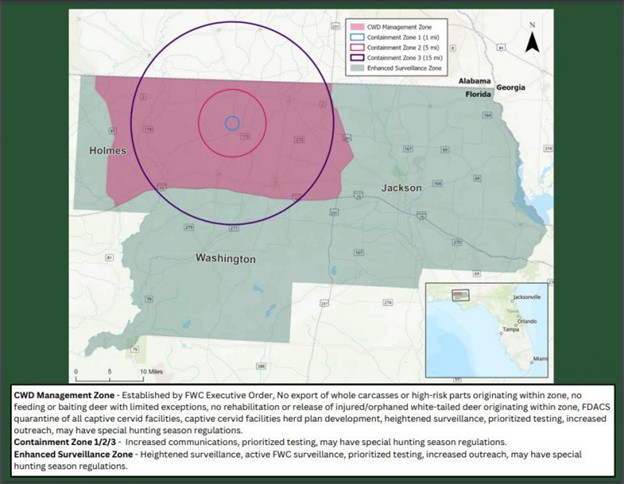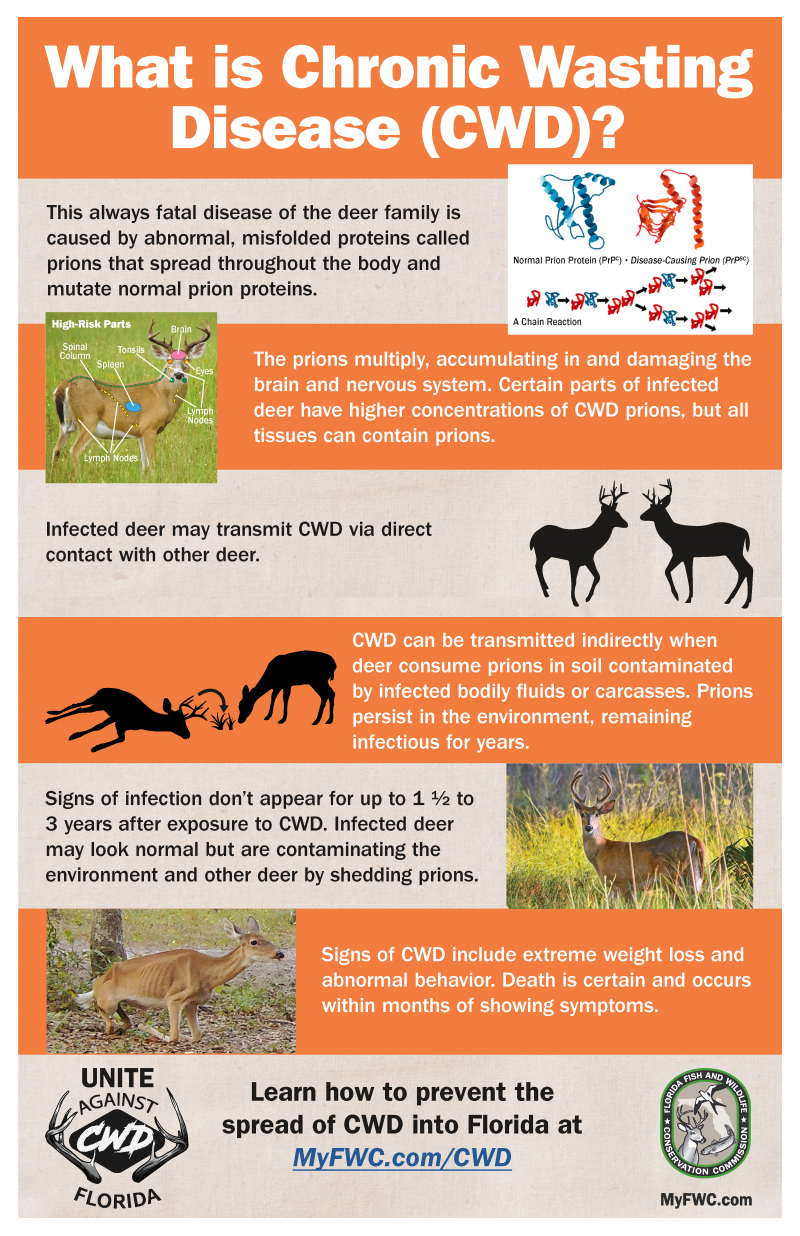Samantha M. Wisely, Wildlife Extension Specialist, Department. of Wildlife Ecology and Conservation, University of Florida
On June 20th, 2023, Florida Fish and Wildlife Commission confirmed the first case of Chronic Wasting Disease (CWD) in a single white-tailed deer approximately 6 miles south of the Alabama border, in Holmes County, Florida. The four and a half year old, road-killed doe was sampled as part of routine disease surveillance. Disease surveillance has been conducted throughout the state since 2002. Since then over 18,000 samples have been submitted for testing from hunter harvested or road-killed deer. Two hundred and fifty of those samples came from Holmes County.
–
What is Chronic Wasting Disease?
Chronic Wasting Disease is a neurodegenerative disease that affects deer, elk, reindeer, and moose. It belongs to a group of diseases known as prion diseases, characterized by the accumulation of abnormally folded proteins (prions) in the brain and nervous system. When the abnormal prion protein comes into close contact with the normally folded protein, the normal protein becomes misfolded, and the body can no longer break it down. The accumulation of these abnormal proteins gradually damages brain tissue and causes a range of neurological symptoms. Affected animals usually experience weight loss, behavioral abnormalities, loss of coordination, excessive salivation, and eventually death. CWD is currently found in both captive and wild deer populations across 31 states in the US and in large parts of Canada (Figure 1).

Figure 1. Distribution of Chronic Wasting Disease in North America as of August 10th, 2023. Courtesy of US Geological Survey
–
Prion proteins are considered infectious and thus the disease can spread to other deer. CWD is spread through direct animal-to-animal contact via saliva, urine, and feces or through environmental contamination including contaminated soil and plants. Recent evidence suggests that the disease can even be spread by ticks.
There is no evidence that CWD can infect people or domestic livestock. Out of an abundance of caution, however, the Center for Disease Control and Prevention recommends not consuming venison that comes from a CWD positive animal.
–
How does CWD impact herd health?
CWD infected animals can remain healthy, yet shed infectious prions into the environment for two to five years, which results in the silent spreading of this disease. Once an animal becomes clinically ill, its health declines quickly and the animal eventually dies from the disease.
CWD poses unique challenges for wildlife management agencies because there is currently no known cure or treatment for infected animals. Efforts to control the spread of CWD involve a combination of surveillance, prevention, and management strategies. These actions include targeted testing of harvested animals, movement restrictions on carcasses or captive cervids, and the establishment of containment areas or zones to prevent further spread. In some regions, managers chose to cull animals to reduce population density and disease prevalence within a population.
–
What actions are being taken in Holmes and Adjacent Counties in Florida?
In response to the increased spread of CWD across the US, the Florida Fish and Wildlife Commission (FWC) and Florida Department of Agriculture and Consumer Services (FDACS) created a CWD response plan in 2017. This plan was activated when the CWD positive deer was discovered in June 2023. The plan set up a geographically defined management zone (Figure 2) surrounding the area where the infected carcass was found.

Figure 2. The CWD surveillance and management zones as of September 1st, 2023. Graphic courtesy of the Florida Fish and Wildlife Commission.
–
Within this management zone:
- It is prohibited to move whole deer carcasses or high-risk carcass parts out of the management zone. Deboned meat, finished taxidermy mounts, and cleaned hide and antlers may be moved out of the zone, as well as skulls, skull caps and teeth as long as soft tissue has been removed. These products are considered approved for removal from the zone.
– - All hunters must submit carcasses for sampling at designated hunter check stations. Lymph node and brain tissue samples will be collected at these stations and tested for CWD. Disposal bins will be provided for disposing soft tissues and unwanted carcass parts.
– - It is prohibited to bait or feed deer within the management zone. The establishment and maintenance of food plots is still allowed.
– - It is prohibited to rehabilitate or release injured or orphaned deer within the management zone.
–
For deer farms and high fence hunting preserves within the management zone:
- Transportation from within the zone to outside the zone will not be permitted. Intra-management zone movement may be permitted on a case by case basis.
– - There will be increased inspections of facilities including mandatory testing of all dead deer, checking fence integrity, evaluating herd inventory practices.
– - All captive deer facilities have been quarantined within the zone. Live animals and whole carcasses are prohibited from leaving the management zone. Approved material may be moved out of the management zone if the tested carcass is negative for CWD. Approved material includes deboned meat, finished taxidermy mounts, and cleaned hide and antlers as well as skulls, skull caps and teeth as long as soft tissue has been removed.
–
As of September 6th, 2023, FWC has not announced if they will change bag limits or season length within the management zone in response to CWD. They will enhance surveillance across the larger surveillance zone (Figure 2) by increasing hunter check stations and taking samples from taxidermy services in order to increase the number of animals that they test from within the surveillance zone. The goal is to test between 300 to 600 animals from the region during the 2023-2024 hunting season. If additional animals test positive, the management zone will be adjusted to include those additional cases.
Hunters are advised to follow best practices when handling carcasses or processing meat to minimize the risk of contamination and spread of the disease. Proper disposal includes placing carcass material in a doubled bag and disposing of the bag in household garbage for collection by a waste disposal provider or direct disposal in a Class 1 landfill. Do not dispose of a carcass in a burn pile or in a water body as this has the potential to spread the infectious prions.
CWD has never been reported in a person, but as a precaution, the US Centers for Disease Control and Prevention advise not to consume infected meat. Store deboned meat in a freezer until test results are returned.
–
Links to more information
–
Florida Fish and Wildlife Commission – Information on CWD in Florida
–
University of Minnesota Center for Infectious Disease Research and Policy – Information about CWD biology
–
Centers for Disease Control and Prevention – Information about human health and CWD
–
UF IFAS Cervidae Health Research Initiative – Resources for Florida deer farmers
- Armadillo Biology, Management, and Disease in the Panhandle - February 21, 2025
- Crop Damage from Deer in the Panhandle - August 15, 2024
- Status Update on Wild Turkeys in the Panhandle - February 23, 2024

